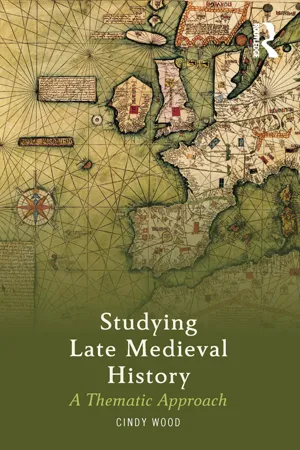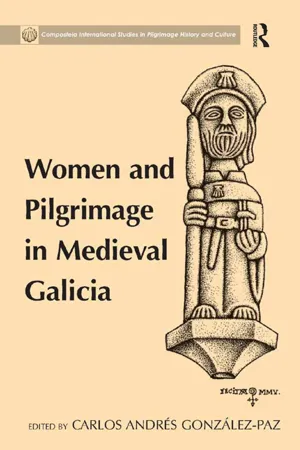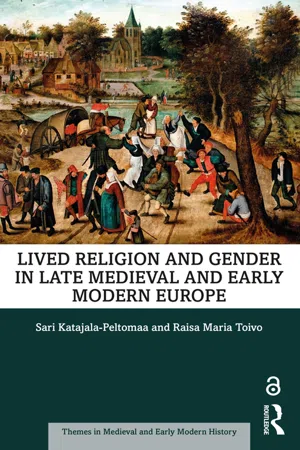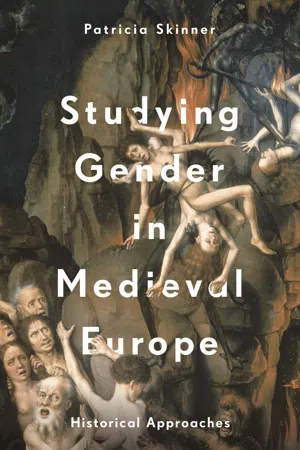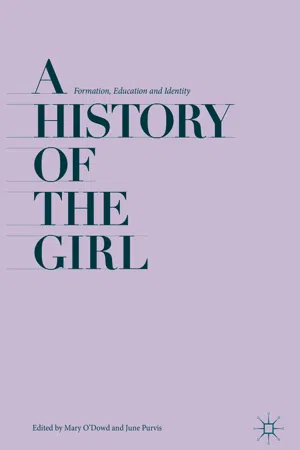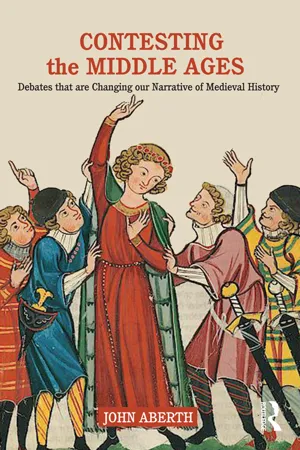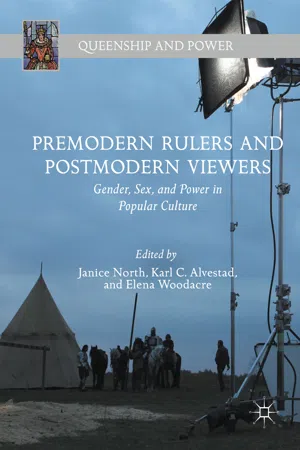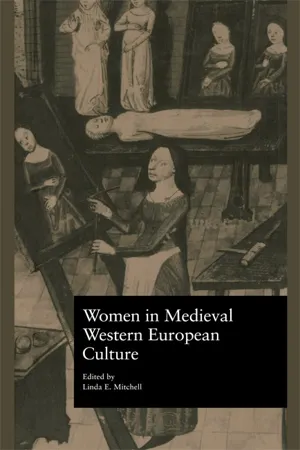History
Women in Medieval Times
Women in Medieval Times played diverse roles, including those of noblewomen, peasants, and religious figures. They were often expected to manage households, bear children, and support their husbands in their pursuits. While some women had limited rights and opportunities, others were able to wield significant influence and power within their communities.
Written by Perlego with AI-assistance
Related key terms
10 Key excerpts on "Women in Medieval Times"
- eBook - ePub
Studying Late Medieval History
A Thematic Approach
- Cindy Wood(Author)
- 2016(Publication Date)
- Routledge(Publisher)
5 Women in medieval Europe DOI: 10.4324/9781315618524-5Traditionally the writing of narratives of elite males, and political and ecclesiastical history have dominated history, especially in the nineteenth century. The development of ‘history from below’ and gender studies since the Second World War and especially the 1960s has moved on from this position. Gender studies and especially the history of women is now a respected area of academic research, but it is a contentious issue in gender studies that women are treated as ‘separate’, when in fact their lives were always intrinsic to life in general. Although women and men did live in the same society this chapter will look at the experience of women and their lives in different contexts, while acknowledging that these were often within a male dominated society. Whereas women may not have had much overt power in this period, they were not always powerless.Women in the medieval period were in many ways very similar to those of today, acting as mothers, sisters, daughters and often lovers. It was the conventions of the time that dictated how these relationships evolved, developed and operated. Society and its rules were different from ours, and women’s experiences need to be seen in this context, rather than judged in comparison to today’s society. Women of all types lived with men, even those who chose to live a secluded, religious life away from society, as men were needed to act as their priests to perform Mass. This activity was barred (and still is) for women in the Roman Catholic Church. Women as wives, daughters, widows or nuns also required men to administer their lands, provide legal support and act as overseers. In general terms if men of this period could be categorised (VERY roughly) as monks, knights or peasants, then women could be categorised as wives, mothers or virgins (that is those who dedicated their lives to the Church). - eBook - ePub
- Carlos Andres Gonzalez-Paz(Author)
- 2016(Publication Date)
- Routledge(Publisher)
Chapter 1Women and the Christian Middle Ages The Theoretical Horizon María Isabel Pérez de Tudela VelascoGeneral Considerations
Any discussion of the position of women during the Middle Ages is a challenge that is as exciting as it is arduous. The developments in the study of the position of women in recent years have revealed the complexity of the question.1 It is not, therefore, excessive to assert that the ‘subject of women’ is one of the most difficult areas of the study of human history. Difficult because of the dearth of evidence and documents referring to women and the laconic style that characterises those examples that there are, but also because of the disparity between the cultural frameworks in which groups of women developed – and continue to develop – the roles assigned to them (or, using classical vocabulary, the charismas assigned to them). Complex too, because diverse circumstances caused each woman to draw on the powers and economic resources with which fate had provided her. These circumstances were and are increasingly determining as women were and continue to be much more limited in their initiatives than their male contemporaries.Undoubtedly, there are significant differences separating Christian and Jewish women, and also between them and Muslim women – and the same applied in the Middle Ages. Furthermore, then, the condition of younger women differed from that of elderly women, while the situation of married women was very different from that of consecrated women, and tangible boundaries separated wealthy and powerful women from those not possessing property and social resources. Daring and enterprising women may have enjoyed advantages over those who were fearful and pusillanimous but these are still to be determined. All these factors must be taken into account, quite apart from the fact that the dividing line most commonly used by those who studied and described medieval society from within (led by preachers and moralists) separated women into two groups: ‘honest’ women and ‘ignoble’ women. Among the first group were those who adapted their code of conduct to meet the dominant system of values, unlike the second group, who were not willing – or, in too many cases, were not able – to make such adjustments to their way of life. - Sari Katajala-Peltomaa, Raisa Maria Toivo(Authors)
- 2020(Publication Date)
- Routledge(Publisher)
Modern scholars have approached this interdependency in various ways. Gender historians have often treated gender as a social category that produces social hierarchies and relationships of power. This was highlighted in research focusing on medieval misogyny as reflected in clerical rhetoric, which for the major part dominated the first works on medieval or early modern women. Since women do not particularly stand out in many sorts of medieval source material, the first phase of research was dedicated to finding women in the sources. Negative stereotypes – in addition to saints and queens, women with actual political power – were most easily found; the early phases of the study of medieval women were dominated by the opposite poles of hierarchy, depicting a black and white image of medieval gender order. 6 Understood as a component of hierarchies and power relationships, gender was also a tool in researching medieval and early modern workshop production and profit division, trade and production, and household order and human reproduction. The first developers of medieval and early modern gender history theory were in fact economic historians. The questions that arose from this kind of understanding of gender concerned the exclusion of women from the labour market – especially skilled labour in the early modern period – and from the control of economic means of power, capital and the kind of labour that produced the control of resources. While women certainly worked in households, in care, and even in workshops, gender historians pointed out that their work did not give them power. Trends of explaining gender in the pre-modern at first emphasised either a deterioration of women’s positions after the ‘golden age’ of the Late Middle Ages or a gradual embitterment of everything, gender included, with modernisation. Finally, the emphasis of gender historians, especially economic historians, settled on the notion Judith Bennett epitomises in her History Matters- eBook - ePub
- Michelle M. Sauer(Author)
- 2015(Publication Date)
- Bloomsbury Academic(Publisher)
CHAPTER FIVE The political sphere: Power, labor, and economics“One of the greatest constraints upon medieval women was economic,” write the editors of Sisters and Workers in the Middle Ages .1 Indeed, economic issues shaped the lives of women in the religious life as well as the secular, and men benefited from women’s lack of economic power. Feminist historians face some daunting challenges when looking into how economics affected gender roles. Barbara A. Hanawalt succinctly sums up the main issue—there are simply not very many records that reflect women’s involvement, both because of the time periods under study, and because women did not “count” under the law.2 By shifting the focus from “masculinist studies” of economic institutions to looking at actual production structures, such as guilds, and consumption issues, Theresa Earenfight suggests that we can deepen and expand our understanding of gendered power relationships and “social and cultural capital.”3 Moreover, we can shift our perspective of what it is we are looking for, as Christopher Cannon recommends, if we look at “the difficult process of the recording the life [of a medieval woman] . . . as the difficult process of living.”4 Thus legal theory about women, coupled with the lack of direct testimony can reveal another space in which we can address issues of gender. Similarly, lack of regulations regarding victualling and ale brewing may have provided easier access to women’s entrance into those economies.Working women challenged both gender roles and gender assumptions. Certainly, in any agrarian-based society, as medieval Europe decidedly was, all members of the household participate in the economic maintenance of the family unit. Wives were generally expected to oversee the daily aspects of living. On farms, this primarily meant housekeeping, food preparation and preservation, and household maintenance. Of these, food preparation and preservation was the most time-consuming. Cows had to be milked before cheese and butter could be made. Harvested grain was ground at the common mill, but bread needed to be prepared and baked daily. Animals had to be fed and watered. Eggs were gathered. Gardens were planted and weeded. Foods were dried, salted, or smoked for preservation. Flax and wool were soaked and spun into yarn and cloth. Village living was similar, except with fewer animal husbandry duties. In each of these cases, the women and men both toiled as a means of survival, and each was interdependent upon the other for success. Yet, despite the necessity of her contributions, the peasant woman was still subject to male control and ownership. - eBook - ePub
Money, Power, Dominance
How Electronic Media Changed Our Culture
- Steven Kuhn(Author)
- 2022(Publication Date)
- Austin Macauley Publishers(Publisher)
2. Womanhood and Femininity
Reflections on the Treatment of Women in England – from the medieval period to the twenty first century.Many of us will recall with great detail the first time visiting a friend’s house after establishing an affiliation in the playground, I am certainly not an exception. The requirement of literal warmth in the family abode was initially derived from a wood fireplace. Many of us may still reside in a home with an original wood fireplace, tending to its kindling to keep its homely heat circulating, despite most modern homes featuring a digital holographic fire with a heating system. Though what is remarkably forgotten is that the power associated with tending to fire is essentially the stigmatism which was indicative of the secondary status women in Britain.Medieval England essentially broke the identity of women into three separate categories: virgins, wives and widows. The categorisation of virgin was ultimately a mere authority dynamic; many men encouraged women to masturbate (against the Christian doctrine) in order to purge themselves of bodily excesses. Young virgins were also useful pawns in the business of marriage, some being betrothed at the tender age of six.The categorisation of wives was one of an arguably progressive nature, since this involved some of the earliest paid jobs for women in post-conquest England. Working women in this age were, for the most part, live-in servants or labourers, though this ended once they were married. At such a point, the wife assumed the role of the house mistress, which often included: shearing sheep, milking cows or growing vegetables and herbs. The progressive nature of this social construct is such that the husband and wife were quite the team in regards to work, there was no division of tasks and no prevailing gender roles.As sale and consumption of ale began to circulate in the town markets, home-brewing became a lucrative business venture. ‘Ale-wives’ were not at all uncommon, women of every class and background would brew ale to be sold at market. - eBook - ePub
Studying Gender in Medieval Europe
Historical Approaches
- Patricia Skinner(Author)
- 2018(Publication Date)
- Bloomsbury Academic(Publisher)
and modern society. And – as Virginia Woolf articulated so elegantly in 1929 – having ‘a room of one’s own’ was and is a still struggle. To these examples of social injustice we could add many more, and medieval historical research can strengthen and deepen movements of resistance.Campaigners for women’s rights in the 1970s and 1980s also focused on the dynamics of how power and knowledge were transferred between generations. Some female writers were held up as early champions of ‘feminism’ for pushing back against the misogynist ideas of their age, but attention also focused on women’sagency Ability to effect change for oneself or others, independently or collaboratively, their ability to grasp and hold onto power and influence through their actions or life cycle events such as marriage and motherhood. A focus on women and power emerged in feminist medieval history, and was championed by scholars such as Pauline Stafford, Janet Nelson (see Chapters 4 and 5 ), Suzanne Fonay Wemple and others. It may be no accident in Anglophone scholarship that considerable work was done on women and power during the decade following an era of powerful women leaders of the United Kingdom, India, Pakistan and Israel (whether this will be repeated in our own era, with women leading many more nation states, is yet to be seen). Rapidly, however, the focus changed to an emphasis on women’s power in relation to that of men, and the emergence of gender studies that explicitly offered a broader interpretation of power and emphasized itscontingency Reliant on other factors, not fixed. But whilst Joan Scott championed gender as a ‘useful category of analysis’, its very openness to interpretation provoked antipathy as well, as we shall see.A gendered reshaping of the medieval starts in Chapter 3 with recognizing the gendered understanding of the human body, and the ways in which authority is claimed over it. Monica Green has been at the forefront of examining women’s experiences of healthcare across a lengthy continuum, in particular the ways in which areas of medicine specific to women’s bodies, gynaecology and obstetrics (the field concerned with pregnancy and childbirth) became dominated by male medical practitioners and increasingly ‘medicalized’ between the medieval and early modern periods. Her work engages directly with the ways in which the life and health of the baby (representing the father’s living legacy) can often take precedence, still, over that of the mother, leading to invasive interventions in the birth by ‘professionals’. Men’s bodies, whilst not so prominent in a medical literature promoting fertility, feature more heavily in legal sources about interpersonal violence and injury, and the ‘maimed man’ might occupy a liminal place in his community. Also discussed is one of the most controversial (and thus stimulating) books published at the start of the 1980s, John Boswell’s Christianity, Social Tolerance and Homosexuality: Gay People in Western Europe from the Beginning of the Christian Era to the 14th Century - eBook - ePub
A History of the Girl
Formation, Education and Identity
- Mary O'Dowd, June Purvis, Mary O'Dowd, June Purvis(Authors)
- 2018(Publication Date)
- Palgrave Macmillan(Publisher)
adolescent girl, however, has led historians to focus more specifically on the different types of work undertaken by girls in towns as well as in the countryside.Medievalists and gender historians have begun to document girls working independently or on behalf of their familiar household, particularly in the fourteenth and fifteenth centuries in northern France and England . Girls’ access to independent employment seems to have been more difficult in southern Europe (with the notable exception of slaves or servants), where the application of Roman law tended to exclude them. Yet, as both textual and visual sources reveal, girls in most parts of medieval Europe worked with their fathers or brothers within the family workshop . Through an analysis of different types of sources, this chapter explores the role of girls and young women in urban workshops . There is a particular focus on girls engaged in paid artistic crafts, such as painting , embroidery , and work with gold or silver .Apprenticeship
Female apprentices appear in medieval London archives from the late thirteenth century. According to the laws of the City of London, a girl could be apprenticed to a woman or a man. For the female teenager, the period before marriage was one of freedom, and girls were aware of this independence and form of autonomy. Villagers came from the countryside to work in towns as servants or apprentices. Most young girls worked in small shops or as servants , seamstresses , laundresses , brewers , tapsters , or hostelers .5 Few secured skilled work, and most worked for short periods of time before they married. Domestic service allowed girls to leave the family home, save a little money for their marriage , and choose their husbands more freely. Some benevolent employers bequeathed small sums of money to their female servants, but wages were low for live-in servants , who were provided with lodging, clothing, and food.6 - eBook - ePub
Contesting the Middle Ages
Debates that are Changing our Narrative of Medieval History
- John Aberth(Author)
- 2018(Publication Date)
- Routledge(Publisher)
28 Rigby, “Gendering the Black Death,” p. 746.29 Shulamith Shahar, The Fourth Estate: A History of Women in the Middle Ages , trans. Chaya Galai (London: Routledge, 1983), p. 90; Judith M. Bennett, Women in the Medieval English Countryside: Gender and Household in Brigstock Before the Plague (Oxford: Oxford University Press, 1987), p. 103.30 Medieval Comic Tales , ed. Peter Rickard (Totowa, NJ.: Rowman and Littlefield, 1974), pp. 89–94.31 Edward Bliss Reed, English Lyrical Poetry from its Origins to the Present Time (New Haven, CT.: Yale University Press, 1914), p. 90.32 Reliquae Antiquae: Scraps from Ancient Manuscripts, Illustrating Chiefly Early English Literature and the English Language , eds. Thomas Wright and James Orchard Haliwell, 2 vols (London, 1841–42), 2:196–99.33 Roberta L. Krueger, “Towards Feminism: Christine de Pizan, Female Advocacy, and Women’s Textual Communities in the Late Middle Ages and Beyond,” in Oxford Handbook of Women and Gender , pp. 593–96. Christine is also famous for her Debate on the Romance of the Rose , in which she responded to misogynist elements in Jean de Meun’s poem.34 See Krueger, “Towards Feminism,” p. 596, n. 23, for scholarly works that criticize Christine as an ambiguous or contradictory feminist figure.35 Barbara Hanawalt has argued that medieval women were marginalized in terms of their physical space, i.e., being confined to the home or allowed out in public only under certain conditions. But her proof of this, that coroners’ inquests reveal greater percentages of women killed in private spaces such as houses compared to men, has been challenged on the grounds that such deaths only reflect the danger inherent in certain tasks, whether performed in public or private, and not the degree to which men or women spent time in such spaces. The extent of spatial marginalization of women also may have varied greatly by social status and regional customs. See: Barbara A. Hanawalt, “At the Margin of Women’s Space in Medieval Europe,” in Matrons and Marginal Women in Medieval Society , eds. Robert R. Edwards and Vickie Ziegler (Woodbridge, UK: Boydell and Brewer, 1995), pp. 8–9; Barbara A. Hanawalt, “Peasant Women’s Contribution to the Home Economy in Late Medieval England,” in Women and Work in Preindustrial Europe , pp. 7–10; P.J.P. Goldberg, “The Public and the Private: Women in the Pre-Plague Economy,” in Thirteenth Century England, III , eds. P.R. Coss and S.D. Lloyd (Woodbridge, UK: Boydell Press, 1991), pp. 75–89; Mate, Women in Medieval English Society , pp. 31–32; Sarah Rees Jones, “Public and Private Space and Gender in Medieval Europe,” in Oxford Handbook of Women and Gender - eBook - ePub
Premodern Rulers and Postmodern Viewers
Gender, Sex, and Power in Popular Culture
- Janice North, Karl C. Alvestad, Elena Woodacre, Janice North, Karl C. Alvestad, Elena Woodacre(Authors)
- 2018(Publication Date)
- Palgrave Macmillan(Publisher)
In restricting women to purely domestic, behind-the-scenes roles, reducing what power they did have then or now to their influence over men through sex or maternity or magic, the modern conception of the medieval gives less latitude to women than the medieval period did. This emphasis on sexuality and maternity as a medieval woman’s only means of agency panders to modern conundrums that cannot reconcile the public and the domestic and, furthermore, demonstrates our modern fidelity to deeply held premodern suspicions about the dangers of female bodies and speech. The message of The White Queen that female ambition is manifestly destructive makes all its lead characters into a type of Eve, pursuing their own and their family’s advancement at the cost of bloodshed and mayhem. In this light, the terms for conceptualizing and evaluating women’s power have not shifted significantly from the premodern to the present. The depictions in The White Queen rather demonstrate how familiar these literary and historical stereotypes about women are to modern audiences. Only when our own lexicon of women’s power expands will modern audiences be able to truly appreciate the complexity of medieval women’s lives and accede women real equality in our own historical moment. Notes 1. Starz Entertainment LLC, “The White Queen: Series Info,” accessed 28 April 2017. https://www.starz.com/series/thewhitequeen/episodes/info. 2. IMDb.com, “The White Queen,” accessed 29 January 2017. http://www.imdb.com/title/tt2372220/. 3. Philippa Gregory, David Baldwin, and Michael Jones, Women of the Cousins’ War: The Duchess, the Queen, and the King’s Mother (New York : Simon & Schuster, 2011), 24. 4. Jennifer C. Ward, English Noblewomen in the Later Middle Ages (New York : Longman, 1992), 2–3, 34; Gregory, Women of the Cousins’ War, 19–20; see also Gregory, “History vs - eBook - ePub
- Linda E. Mitchell(Author)
- 2012(Publication Date)
- Routledge(Publisher)
One of the reasons that there was such an eager concern to have women marry, in spite of the expense of the dowry, is that both men and women feared that women outside marriage would fall into prostitution. There may have been an overbalance of women in the period following the Black Death of 1348–49, as there is some evidence that the plague spared more women than men. The evidence is not strong, but several indicators point to a surplus of women. One is the number of women, particularly in the Low Countries and the Rhineland of northern Europe who became Beguines, women who did not take the vows of a nun, instead living together in urban homes earning a living through cloth work and spending their spare time on charity. During the fourteenth and fifteenth centuries the regulation of brothels for prostitution also became a major urban preoccupation. City fathers throughout Europe regulated the clothing, the housing, and areas where prostitutes could ply their trade.The economic activities of most urban women, however, were not tied either to prostitution or to chaste weaving and charity. Most of women's work was related to their traditional roles within the family household. Women were frequently employed in the textile industry. The distaff for spinning thread was the universal symbol of women in the Middle Ages, and, in fact, the term “spinster,” meaning literally someone who spins, came to mean a single woman precisely because so many single women in the Middle Ages made their living by spinning. It is hardly surprising to find that women's domestic duty to spin was taken up into the textile industry as a whole. Women appear in all stages of cloth production, from the earlier, less-skilled stages such as carding and combing wool or unwrapping silk cocoons to the more advanced stages requiring fine embroidery skills, such as creating fine goods for headgear or silk points for lace. Women, however, tended not to do commercial weaving with large looms or dying, fulling, and finishing woolen cloth. Some textile crafts were worked only by women; in thirteenth-century France, for instance, the trades of silk spinning with small and large spindles, ribbon making, and millinery were women's trades. By the fifteenth century, London women dominated the silk spinning and weaving crafts, and the women of Cologne controlled the trades of silkmaking, linen yarn finishing, and gold thread spinning.Women were also well represented in victualling trades that involved providing food. They were particularly common as brewsters, making their own ale to sell, and tapsters, selling other brewers’ ales. Ale and beer were most people's daily beverages in the Middle Ages, and brewing was an industry which could be carried out in the home, using ordinary pots and vats. Women's involvement in the brewing industry also led to their participation in running taverns and hostels where they could retail their brew. They were also active as hucksters in such small retail trades as street vendors of eggs, butter, cheese, bread, beer, fruit, vegetables, fish, poultry, and other items. Many worked as bakers.
Index pages curate the most relevant extracts from our library of academic textbooks. They’ve been created using an in-house natural language model (NLM), each adding context and meaning to key research topics.
